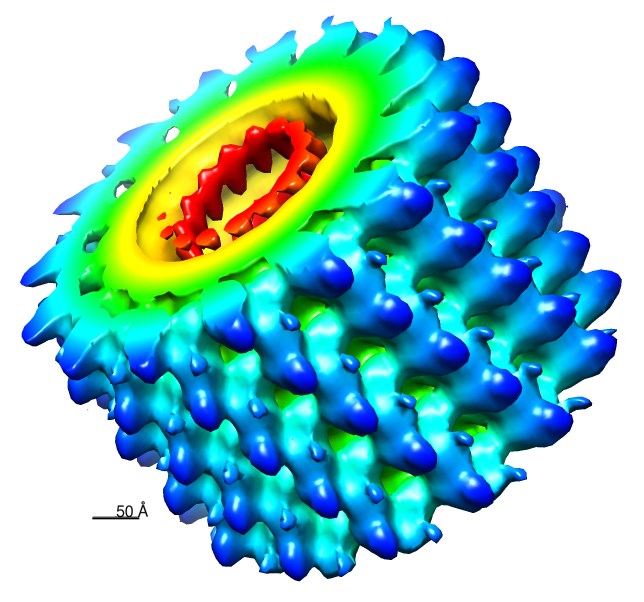Marburg Virus
Gene therapy is a novel technique to treat cancers and genetic disorders, and the development of safe and efficient delivery systems benefits to practical clinical protocols. Lentiviral vector system is usually used in gene therapy. At Creative Biolabs, our techniques could modify lentiviral vectors and utilize the envelope proteins of retroviruses to enhance the directing to a particular cell type. Currently, we focus on the molecule structure of Marburg viruses and offer comprehensive pseudotyping services by using this virus glycoproteins for targeting lung cells and myocytes. Based on advanced platforms and skillful expert teams, we can ensure the stability, low-toxicity, and host-cell specificity of the final deliverable product of viral particles.
Pseudotype Formation Using Marburg Virus Glycoproteins
 The Marburg virus (MBG) is an infectious agent belonging to the Filovirus family that has caused lethal outbreaks of hemorrhagic fever in humans and non-human primates, as well as the Ebola virus (EBO). It is an RNA virus that can carry host-derived envelopes, and also a unique but relevant transmembrane glycoprotein (GP) that may mediate cellular binding and fusion. The highly glycosylated GP reveals conservation in the C- and N-terminal regions while more variability in the middle.
The Marburg virus (MBG) is an infectious agent belonging to the Filovirus family that has caused lethal outbreaks of hemorrhagic fever in humans and non-human primates, as well as the Ebola virus (EBO). It is an RNA virus that can carry host-derived envelopes, and also a unique but relevant transmembrane glycoprotein (GP) that may mediate cellular binding and fusion. The highly glycosylated GP reveals conservation in the C- and N-terminal regions while more variability in the middle.
The host range of lentiviral vectors can be expanded by a process namely pseudotyping. Pseudotyped lentiviral vectors consist of vector particles bearing GPs derived from enveloped viruses. Former evidence has described a successful pseudotyping of human immunodeficiency virus type 1 (HIV-1) vectors using MBG-derived virion GPs. The first and the most widely applied GPs for pseudotyping lentiviral vectors is vesicular stomatitis virus glycoprotein (VSV-G), and now MBG draws increasing attention due to its broad tropism and stability of the resulting pseudotypes.
Pseudotyping of LVs with MBG-GPs at Creative Biolabs
Lentiviral vectors such as HIV, feline immunodeficiency virus (FIV), and equine infectious anemia virus (EIAV) have been pseudotyped with a lot of envelope glycoproteins, for instance, those from VSV, MBG, EBO, rabies virus, lymphocytic choriomeningitis virus (LCMV), etc. Pseudotyping of the lentiviral vector with certain envelopes allows particle concentration by ultracentrifugation, but varied pseudotyped vectors differ in stability, efficiency of packaging and hence virus titers.
Recently, the development of powerful viral gene transfer therapies has significantly facilitated the study of gene function. The envelope for lentiviral vector pseudotyping, including MBG, has specific advantages and characterizations. Pseudotype viruses packaged by MBG glycoproteins mediate infection of a comparable wide range of cell types in mammalian. As a reliable partner with a high reputation in gene therapy, Creative Biolabs provides one-stop services to redesign vectors to improve gene transfer and to further increase safety. Moreover, the pseudotyped vector exhibits different tissue tropisms in vivo. As known, an HIV-based lentiviral vector pseudotyped with MBG glycoprotein effectively transduced lung epithelial cells from the apical surface. Meanwhile, such a vector is more efficient in transducing myocytes to elicit therapeutic procedures.
 Figure 2. Schematic diagram showing lentiviral vector-based gene delivery into target host cells. (Hu, 2016)
Figure 2. Schematic diagram showing lentiviral vector-based gene delivery into target host cells. (Hu, 2016)
Features
- Transduce cells with high efficiency
- High-level expression and long-term stability
- Limited cytotoxicity
- Inducing negligible immune response in vivo
The key step of gene therapy is to create safe and efficient delivery vehicles. Lentiviral vectors have proven to be promising tools for the transduction of a diversity of cells in vivo and in vitro, such as myocytes, lung cells, and central nervous system cells. Creative Biolabs always devotes to designing and modifying different lentivirus vectors, with safer and higher titers to meet clients' all needs on specific projects. For more information, please feel free to contact us.
Reference
- Hu, S. (2016). Pseudotyping of lentiviral vector with novel vesiculovirus envelope glycoproteins derived from chandipura and piry viruses. Virology. 1-163.
